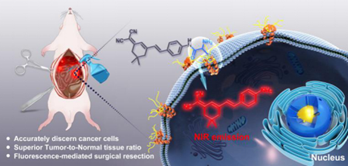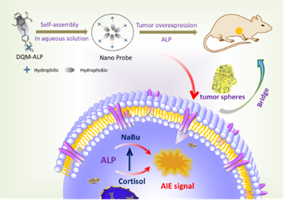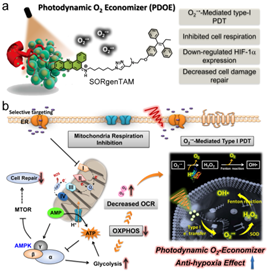
Source: School of Chemical Engineering
By Li Xiang, Li Haidong, Li Mingle
China’s dye industry is entering a new era of high-quality development characterized by structural adjustment, product upgrading and green development. As typical high value-added fine chemicals, biomedical dyes have already been used in various fields such as environmental detection, bio-labeling, disease diagnosis, as well as cancer treatment. Especially for cancer biomedicine, functional dyes play vital role in tumor diagnosis and therapeutics. Recently, the team of Academician Xiaojun Peng of State Key Laboratory of Fine Chemicals at DUT has made a series of breakthroughs in the field of fluorescence diagnosis and treatment of tumors, promoting the development of high-performance functional dyes for cancer theranostics application.
1. The recurrence of malignant tumors is mostly caused by incompleted surgical resection. Especially, it is difficult for surgeons to detect and accurately remove metastatic tumors by predominantly using visual examination and palpation owing to the lack of effective means to specifically distinguish the boundary range between normal and tumor tissues. Thus, the development of activated fluorescent probe with superior tumor-to-normal (T/N) tissue ratios is particularly urgent in clinics. In view of CD13/aminopeptidase N (APN) regarded as a cancer-specific biomarker, mediating with progression, invasion, and migration of malignant tumor, herein, we reported an APN-responsive fluorescent probe YH-APN and demonstrated its application to distinguish cancer cells. Through in situ spraying manner, fluorescent superior tumor-to-normal (T/N) tissue ratios (subcutaneous transplantation tumor, 13.86; hepatic metastasis, 4.42 and 6.25; splenic metastasis, 4.99) were achieved. More importantly, we have demonstrated the ability to image metastasis tumor tissue less than 1 mm in diameter, highlighting the potential for this probe to be used as a tool in surgical resection. This research may spur the use of enzyme-activatable fluorescent probes for the progress of tumor diagnosis and image-guided surgery (IGS).

Monitoring fluctuations in enzyme overexpression facilitates early tumor detection and excision. An AIEgen probe (DQM-ALP) for the imaging of alkaline phosphatase (ALP) activity was synthesized. The probe consists of a quinoline-malononitrile (QM) core decorated with hydrophilic phosphate groups as ALP-recognition units. The rapid liberation of DQM-OH aggregates in the presence of ALP resulted in aggregation-induced fluorescence. The up-regulation of ALP expression in tumor cells was imaged using DQM-ALP. The probe permeated into 3D cervical and liver tumor spheroids for imaging spatially heterogeneous ALP activity with high spatial resolution on a two-photon microscopy platform, providing the fluorescence-guided recognition of sub-millimeter tumorigenesis. DQM-ALP enabled differentiation between tumor and normal tissue ex vivo and in vivo, suggesting that the probe may serve as a powerful tool to assist surgeons during tumor resection.

This work was collaborated by the team of Academician Xiaojun Peng and the team of Academician Juyoung Yoon of Department of Chemistry and Nano Science at Ewha Womans University. The first author of the article is Haidong Li, a PhD graduate from DUT (now a postdoctoral fellow at Ewha Womans University).
2. Tumor hypoxia has proven to be the major bottleneck of photodynamic therapy (PDT) to clinical transformation. Different from traditional O2 delivery approaches, here we describe an innovative binary photodynamic O2-economizer (PDOE) tactic to reverse hypoxia-driven resistance by designing a superoxide radical (O2•–) generator targeting mitochondria respiration, termed SORgenTAM. This PDOE system can block intracellular O2 consumption and down-regulate HIF-1α expression, which successfully rescues cancer cells from becoming hypoxic and relieves the intrinsic hypoxia burden of tumors in vivo, thereby sparing sufficient endogenous O2 for the PDT process. Photosensitization mechanism studies demonstrate that SORgenTAM has an ideal intersystem crossing rate and triplet excited state lifetime for generating O2•– through type-I photochemistry, and the generated O2•– can further trigger a biocascade to reduce the PDT’s demand for O2 in an O2-recycble manner. Furthermore, SORgenTAM also serves to activate the AMPK metabolism signaling pathway to inhibit cell repair and promote cell death. Consequently, using this two-step O2-economical strategy, under relatively low light dose irradiation, excellent therapeutic responses toward hypoxic tumors are achieved. This study offers a conceptual while practical paradigm for overcoming the pitfalls of phototherapeutics.

This work was collaborated by the team of Academician Xiaojun Peng and the team of Academician Jong Seung Kim of Department of Chemistry at Korea University. The first author of the article is Mingle Li, a PhD graduate of DUT (now a postdoctoral fellow at Korea University).
The above research is strongly supported by the National Natural Science Foundation of China, the NSFC Group Project, the NSFC-Liaoning Joint Fund, and the National Research Foundation of Korea.
Editor: Li Xiang